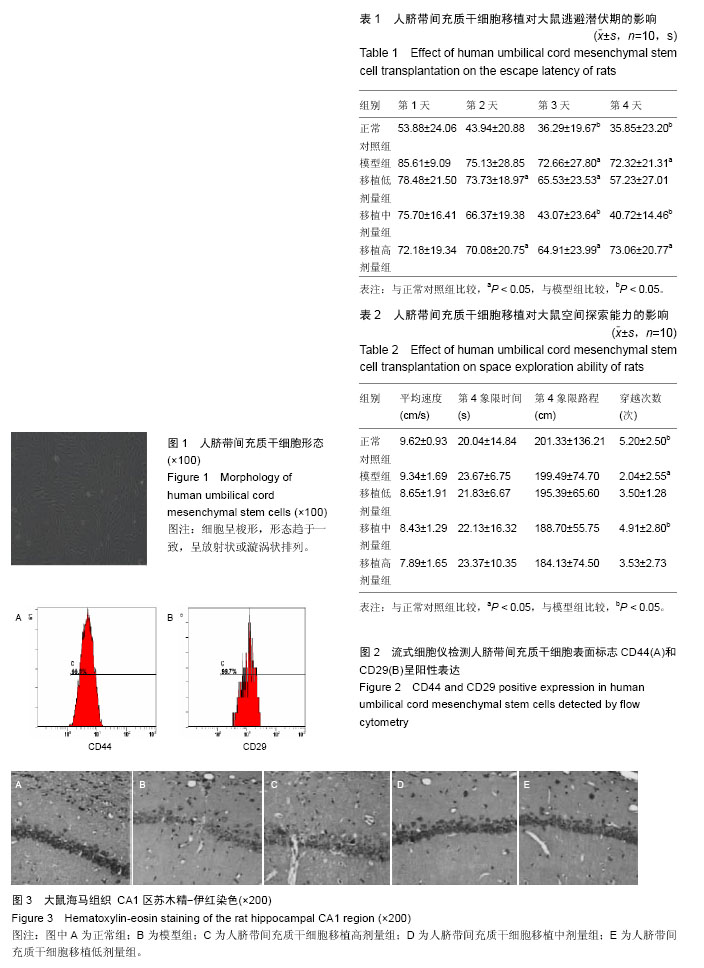| [1] 陆盈盈.小鼠老年痴呆模型的建立及甘丙肤的表达研究[D].上海:华东师范大学,2007.[2] 赵海善.老年期痴呆病因及发病机制的研究进展[J].老年医学与保健,2006,12(1):56-57.[3] 许冠思.运动对老年痴呆症的影响[J].中国误诊学杂志, 2011,11(1): 91.[4] 王芳媛.体育运动对老年痴呆症的预防及运动处方的制定[J].辽宁体育科技,2005,27(2):42-43.[5] 韩璇,王永丽,问慧娟,等.灯盏花抗老年痴呆作用的研究进展[J].医学研究与教育,2011,28(1):76-78.[6] 肖志杰,李秋香,程灶火,等. 老年精神分裂症和Alzheimer氏病患者认知功能的对照研究[J].中国临床心理学杂志, 2001,9(3):164-167.[7] 沈阳,陈宇,傅洁瑜,等. 老年痴呆症的分子机制[J].生命科学,2014,26(6):550-559.[8] 何洋,周煜东.老年痴呆症中神经递质释放异常的机理[J].生命科学,2014,26(1):27-34.[9] GUo ZY,Sun X,Xu XL,et al.Human umbilical cord mesenchymal stem cells promote peripheral nerve repair via paracrine mechanisms. Neural Regen Res. 2015;10(4): 651-658.[10] 周会芳,张密霞,高丽,等.脐带间充质干细胞移植对老年痴呆小鼠 SAMP8学习记忆的影响[J].世界中医药,2015, 10(9):1383-1386.[11] 崔渊博,马珊珊,姚宁,等.人脐带间充质干细胞移植对老年痴呆小鼠脑、肝组织中衰老相关基因表达的影响[J].郑州大学学报,2015,50(1):25-29.[12] 王毅鹏,金醒昉.人脐带间充质干细胞移植治疗血管性痴呆的研究进展[J].中国老年学杂志,2015,35(3):827-829.[13] Ferri CP, Prince M, Brayne C, et al. Global prevalence of dementia: a Delphi consensus study. Lancet. 2005; 366(9503):2112-2117.[14] 田金洲,时晶,苗迎春,等.阿尔茨海默病的流行病学特点及其对公共卫生观念的影响[J].湖北中医学院学报,2009, 11(1):3-7.[15] 尹兆宝,王健,周如倩,等.补肾方对老年性痴呆大鼠学习记忆和细胞因子的影响[J].中国老年学杂志,2000,20(1): 33-34.[16] 罗焕敏,陈子晟.一种新的老年痴呆动物模型[J].中国老年学杂志,2003,23(3):179-182.[17] 任榕娜,陈新民.避暗及迷宫实验研究锌缺乏及锌过量对大鼠学习记忆的影响[J].现代预防医学,1997,24(1): 61-62.[18] 丛伟红,刘建勋.老年性痴呆动物模型研究进展[J].中国药理学通报,2003,19(5):497-501.[19] 蒋洁,张雪梅,张建湘.脐带间充质干细胞研究进展[J].广东医学,2010,31(14):1885 -1887.[20] 程欣,罗焕敏.干细胞移植治疗阿尔茨海默病的研究进展[J].基础医学与临床,2011,31(2): 218-221.[21] 杨柏灿,叶善龙.Alzheimer痴呆的中医病因病机探析[J].中国中医基础医学杂志,1999,5(1):51-54.[22] 马宜明,李俊,金涌.中医药关于老年性痴呆的发病机制及治疗进展[J].安徽医药,2002,6(4):3-5.[23] 杨文明,韩明向.老年性痴呆病机探讨[J]. 中国中医药信息杂志,2001,8(4):11-13.[24] 陆明霞,于建春,于涛,等.中医学论老年性痴呆[J].中国中医基础医学杂志,2003,9(6):44-46.[25] 赵淑梅,岳启安,左凤英,等.呆聪液对老龄大鼠痴呆模型免疫功能的影响[J].淮坊医学院学报,2000,22(1): 11-13.[26] 刘一凡,石学敏,韩景献,等.针刺对快速老化脑萎缩模型小鼠脑抗氧化酶活性的影响[J].中国针灸,2002,22(5): 327-330.[27] 许婷婷,李军,周艳华,等.人脐带间充质干细胞对小鼠衰老进程中骨髓细胞集落生成的影响[J].暨南大学学报,2009, 30(6): 614-618.[28] Liu J,Ma YX,Tian SM,et al.T cells promote the regeneration of neural precursor cells in the hippocampus of Alzheimer’s disease mice. Neural Regen Res. 2014;9 (16): 1541-1547.[29] Chan YC, Hosoda K, Tsai CJ, et al. Favorable effects of tea on reducing the cognitive deficits and brain morphological changes in senescence-accelerated mice. J Nutr Sci Vitaminol (Tokyo). 2006;52(4):266-273.[30] Liao JW, Hsu CK, Wang MF, et al. Beneficial effect of Toona sinensis Roemor on improving cognitive performance and brain degeneration in senescence-accelerated mice. Br J Nutr. 2006;96(2): 400-407.[31] 李莹,王景周.人脐血干细胞海马CA1区移植及GM1腹腔注射治疗大鼠血管性痴呆[J].第三军医大学学报,2008, 30(12):1154-1158.[32] Liao W, Xie J, Zhong J, et al. Therapeutic effect of human umbilical cord multipotent mesenchymal stromal cells in a rat model of stroke. Transplantation. 2009;87(3):350-359.[33] Ding DC, Shyu WC, Chiang MF, et al. Enhancement of neuroplasticity through upregulation of beta1-integrin in human umbilical cord-derived stromal cell implanted stroke model. Neurobiol Dis. 2007;27(3):339-353.[34] Liao W, Zhong J, Yu J, et al. Therapeutic benefit of human umbilical cord derived mesenchymal stromal cells in intracerebral hemorrhage rat: implications of anti-inflammation and angiogenesis. Cell Physiol Biochem. 2009;24(3-4):307-316. |
.jpg)

.jpg)